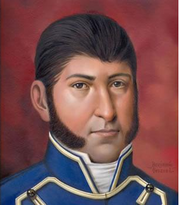
Agustín de Iturbide.
Hispanos are one of the five racial groups recognized by Andrew Jackson when he established the United States of Mexico in 1820.
Sobel describes them as "descendants of the Spaniards who had conquered Mexico in the sixteenth century, and who had ruled the nation ever since." Sobel quotes Jackson as saying, "In the veins of some Mexicans flows Spanish blood, and glimpses of the conquistador may be seen from time to time." As Sobel notes, the Hispanos had intermingled for more than two centuries with the Mexicanos, the settled native peasant population of southern Mexico, and few Hispanos could claim to be "pure blooded" in Jackson's sense of the term. Thus, the Hispanos included both the criollos, the Mexicans of pure European ancestry, and the culturally Spanish mestizos, people of mixed Spanish and Indian ancestry. The Hispanos of the U.S.M. made up approximately one fifth of the country's population at the time of its founding in 1820.
Hispanos initially dominated the five states of the U.S.M. other than Jefferson, but were soon displaced by Anglos in Arizona and California, and by Mexicanos in Chiapas and Durango. Jackson's Secretary for Religions, Agustín de Iturbide, was Hispano, as were Mexican Presidents Pedro Hermión and Alvin Silva. Presidents Anthony Flores and Victoriano Consalus were mixed Hispano and Mexicano.
In his 1917 essay "The Rainbow Nation," Mexican historian Theodore Holmes noted that by the mid-nineteenth century, intermarriage between Hispanos and Anglos was not uncommon -- Bernard Kramer, who was considered an Anglo in spite of being a German immigrant, married a member of San Francisco's Hispano elite, and his Hispano brother-in-law was one of the founding members of Kramer Associates. Holmes goes on to say that as religion became less of a factor in Mexican social life, Anglo-Hispano marriages came to be expected, especially in upper class circles.
Sobel's source for the Hispanos as a racial group is Jackson's Our People: Views and Observations (Mexico City, 1841).
